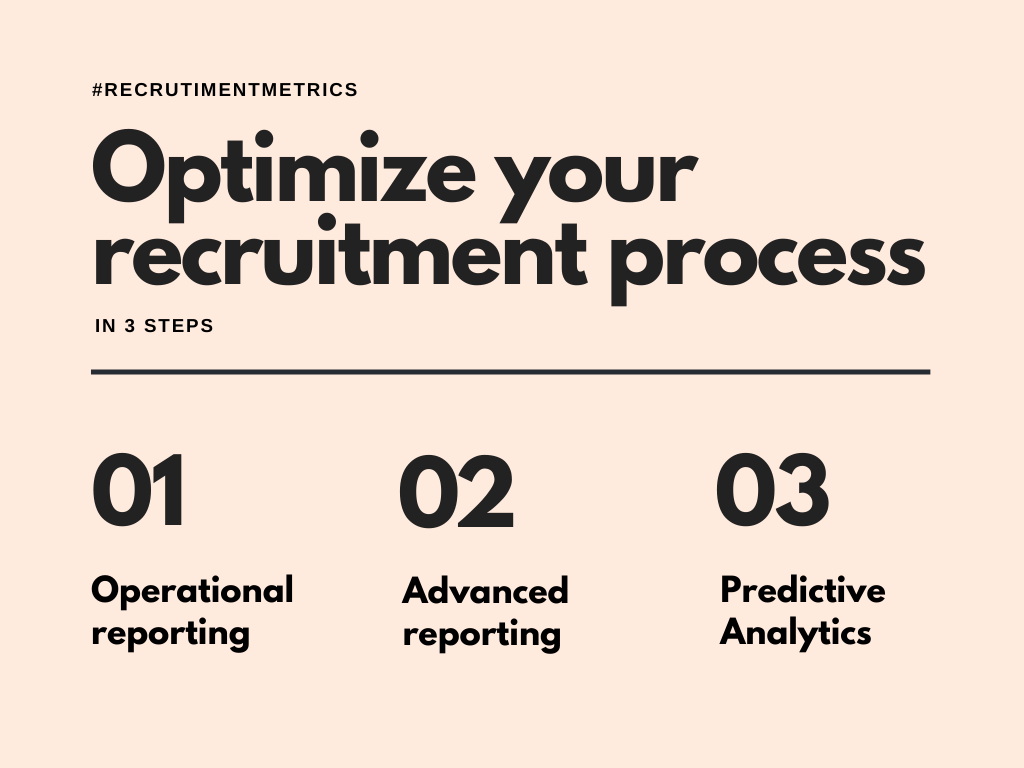
In this article, we will explain what recruiting analytics is, and how to incorporate recruitment analytics in your firm with 3 simple steps and start optimizing your recruiting processes.
Recruitment analytics, also known as recruiting analytics, plays an increasingly significant role in recruitment and staffing firms. Recruitment analytics can help a search firm make better, data-driven choices when it comes to sourcing, hiring, and revenue.
Let’s begin with the basics, what is recruitment analytics?
Before we dive into the advantages that recruitment analytics offers, let’s first look at what recruitment analytics means.
Recruitment analytics is the identification and interpretation of meaningful patterns for job orders, candidate sourcing, hiring, and revenue generation. This means that the data is used to find and explain patterns in your business operations. For example, if new placement falls-out within the first three months, this may indicate a mismatch with the job description and the actual role, hiring mistakes, or a bad client-onboarding process. This is an example of recruitment analytics.
Recruiting analytics can answer several other questions, including:
- Which industry provides you the best job orders?
- Which advertising channel generates the most job orders?
- Which sourcing channel provides the best candidates?
- What is the cost of hire for a position?
- What do your best job orders or candidates have in common?
- Where in your recruitment funnel do most candidates drop out?
- Which positions take the longest to close and why?
Being able to answer these questions is crucial to improve your revenue.
Common data sources for recruitment analytics include your Applicant Tracking System (ATS), Customer Relationship Management (CRM) systems, Candidate platforms like LinkedIn, Monster, etc., Phone systems, and Marketing platforms like Hubspot, etc.
74% of companies are failing at Digital HR Transformation. Sign up for our FREE webinar to see how you can transform your search firm and increase your revenue.
Recruitment Reporting and Analytics
Now that we have a basic understanding of recruitment analytics, let us move a step further. When we look at recruitment analytics, there are three steps we can identify. These are operational reporting, advanced reporting, and (predictive) analytics. The steps are based on the commonly seen HR analytics maturity models.
Step 1: Operational reporting
In step 1, recruitment analytics is descriptive. They represent the well-known core recruiting metrics. Metrics include the cost of hiring, source of hire, applicants per job opening, selection ratio, time to fill, time to hire, hiring manager satisfaction, and more. For a full overview of the best-known recruiting metrics, check our linked articles.
All the measurements listed are moderately easy to capture and analyze by aggregating the legacy data from your ATS. If there is an ATS implemented in your organization, it is usually fairly straightforward to connect the Spotlight Data dashboard to this system, define metrics, and report on them. All these measurements look back at historic data already present in the system and no, or very few, additional calculations are required to report this data.
Step 2: Advanced reporting
Step 2 represents advanced reporting. Reporting on these measurements requires knowledge of statistical tools and requires the combination of multiple data sources.
An example is the candidate experience for success and fall-outs. To assess the candidate experience, different phases in the recruitment cycle need to be mapped and the candidate experience needs to be measured or otherwise collected.
Other metrics include financial recruitment metrics, like the cost per candidate per sourcing channel, sourcing channel conversion, recruitment funnel conversion, per placement average, profit per placement, minimum slate, and so on.
Step 3: Analytics (Predictive Analytics)
Step 3 represents strategic and predictive analytics in recruitment. Strategic analytics involves segmentation, statistical analysis, development of predictive models, and strategic and scenario planning. It helps you assess the results of your past strategies, review the current and predicted growth of the firm, and analyze the impact on the growth with new strategies.
Spotlight Data provides you with real-time operational reporting, advanced reporting, and predictive analysis. Sign up for our FREE webinar to see how you can transform your search firm and increase your revenue.
An example of strategic analytics is segmentation in job advertising and the deployment of programmatic advertisement. In this case, the ad spent (per click or per thousand impressions) should be closely monitored and when needed, adjusted. Because of the segmentation, different advertisements can be tested against different job-seeker segments to optimize conversion and lower cost.
Other examples of analytics are the prediction of an ideal client profile, predicting the associated candidate pipeline, time to hire, and optimization of the recruitment funnel.
